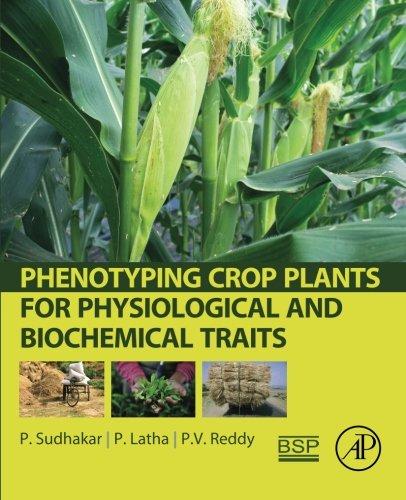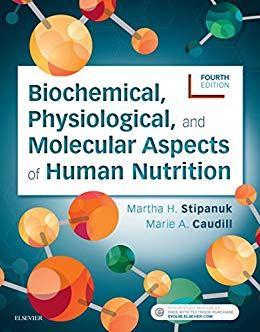Prabhat Kumar Srivastava
(Editor)
Visit to download the full and correct content document: https://ebookmass.com/product/pesticides-in-crop-production-physiological-and-bioch emical-action-prabhat-kumar-srivastava-editor/

More products digital (pdf, epub, mobi) instant download maybe you interests ...

Phenotyping crop plants for physiological and biochemical traits 1st Edition Latha

https://ebookmass.com/product/phenotyping-crop-plants-forphysiological-and-biochemical-traits-1st-edition-latha/ (eTextbook PDF) for Biochemical, Physiological, and Molecular Aspects of Human Nutrition 4th Edition
https://ebookmass.com/product/etextbook-pdf-for-biochemicalphysiological-and-molecular-aspects-of-human-nutrition-4thedition/

Heat stress tolerance in plants: physiological, molecular and genetic perspectives Kumar
https://ebookmass.com/product/heat-stress-tolerance-in-plantsphysiological-molecular-and-genetic-perspectives-kumar/

Biochemical, Physiological, and Molecular Aspects of Human Nutrition E Book 3rd Edition, (Ebook PDF)
https://ebookmass.com/product/biochemical-physiological-andmolecular-aspects-of-human-nutrition-e-book-3rd-edition-ebookpdf/

Fruit Crops: Diagnosis and Management of Nutrient Constraints 1st Edition Anoop Kumar Srivastava (Editor)
https://ebookmass.com/product/fruit-crops-diagnosis-andmanagement-of-nutrient-constraints-1st-edition-anoop-kumarsrivastava-editor/

Fruit Crops: Diagnosis and Management of Nutrient Constraints Anoop Kumar Srivastava
https://ebookmass.com/product/fruit-crops-diagnosis-andmanagement-of-nutrient-constraints-anoop-kumar-srivastava/

Copper in N-Heterocyclic Chemistry 1st Edition Ananya Srivastava
https://ebookmass.com/product/copper-in-n-heterocyclicchemistry-1st-edition-ananya-srivastava/


New and Future Developments in Microbial Biotechnology and Bioengineering: From Cellulose to Cellulase: Strategies to Improve Biofuel Production Neha Srivastava (Editor)
https://ebookmass.com/product/new-and-future-developments-inmicrobial-biotechnology-and-bioengineering-from-cellulose-tocellulase-strategies-to-improve-biofuel-production-nehasrivastava-editor/
Sociology in Action 1st Edition, (Ebook PDF)
https://ebookmass.com/product/sociology-in-action-1st-editionebook-pdf/

PesticidesinCropProduction
PesticidesinCropProduction
PhysiologicalandBiochemicalAction
Editedby
PrabhatKumarSrivastava
DepartmentofBotany,KSSaketPGCollege Ayodhya UttarPradesh,INDIA
VijayPratapSingh
DepartmentofBotany,C.M.P.DegreeCollege AConstituentPostGraduateCollegeofUniversityofAllahabad Prayagraj UttarPradesh,INDIA
AnitaSingh
CentreofAdvancedStudiesinBotany,BanarasHinduUniversity Varanasi UttarPradesh,INDIA
DurgeshKumarTripathi
AmityInstituteofOrganicAgriculture AmityUniversity,UttarPradesh,Noida UttarPradesh,INDIA
SamikshaSingh
RanjanPlantPhysiologyandBiochemistryLaboratory DepartmentofBotany,UniversityofAllahabad,Prayagraj UttarPradesh,INDIA
SheoMohanPrasad
RanjanPlantPhysiologyandBiochemistryLaboratory DepartmentofBotany,UniversityofAllahabad,Prayagraj UttarPradesh,INDIA
DevendraKumarChauhan
D.D.PantInterdisciplinaryLaboratory DepartmentofBotany,UniversityofAllahabad,Prayagraj UttarPradesh,INDIA
Thiseditionfirstpublished2020 ©2020JohnWiley&SonsLtd
Allrightsreserved.Nopartofthispublicationmaybereproduced,storedinaretrievalsystem,or transmitted,inanyformorbyanymeans,electronic,mechanical,photocopying,recordingorotherwise, exceptaspermittedbylaw.Adviceonhowtoobtainpermissiontoreusematerialfromthistitleisavailable athttp://www.wiley.com/go/permissions.
TherightofPrabhatKumarSrivastava,VijayPratapSingh,AnitaSingh,DurgeshKumarTripathi,Samiksha Singh,SheoMohanPrasadandDevendraKumarChauhantobeidentifiedastheauthorsoftheeditorial materialinthisworkhasbeenassertedinaccordancewithlaw.
RegisteredOffice(s)
JohnWiley&Sons,Inc.,111RiverStreet,Hoboken,NJ07030,USA
JohnWiley&SonsLtd,TheAtrium,SouthernGate,Chichester,WestSussex,PO198SQ,UK
EditorialOffice
TheAtrium,SouthernGate,Chichester,WestSussex,PO198SQ,UK
Fordetailsofourglobaleditorialoffices,customerservices,andmoreinformationaboutWileyproducts visitusatwww.wiley.com.
Wileyalsopublishesitsbooksinavarietyofelectronicformatsandbyprint-on-demand.Somecontentthat appearsinstandardprintversionsofthisbookmaynotbeavailableinotherformats.
LimitofLiability/DisclaimerofWarranty
Whilethepublisherandauthorshaveusedtheirbesteffortsinpreparingthiswork,theymakeno representationsorwarrantieswithrespecttotheaccuracyorcompletenessofthecontentsofthisworkand specificallydisclaimallwarranties,includingwithoutlimitationanyimpliedwarrantiesofmerchantabilityor fitnessforaparticularpurpose.Nowarrantymaybecreatedorextendedbysalesrepresentatives,written salesmaterialsorpromotionalstatementsforthiswork.Thefactthatanorganization,website,orproductis referredtointhisworkasacitationand/orpotentialsourceoffurtherinformationdoesnotmeanthatthe publisherandauthorsendorsetheinformationorservicestheorganization,website,orproductmayprovide orrecommendationsitmaymake.Thisworkissoldwiththeunderstandingthatthepublisherisnotengaged inrenderingprofessionalservices.Theadviceandstrategiescontainedhereinmaynotbesuitableforyour situation.Youshouldconsultwithaspecialistwhereappropriate.Further,readersshouldbeawarethat websiteslistedinthisworkmayhavechangedordisappearedbetweenwhenthisworkwaswrittenandwhen itisread.Neitherthepublishernorauthorsshallbeliableforanylossofprofitoranyothercommercial damages,includingbutnotlimitedtospecial,incidental,consequential,orotherdamages.
LibraryofCongressCataloging-in-PublicationData
Name:Srivastava,PrabhatKumar,1983–editor.
Title:Pesticidesincropproduction:physiologicalandbiochemicalaction /editedbyPrabhatKumarSrivastava,DepartmentofBotany,KSSaketPG College,Ayodhya,Faizabad[and6others].
Description:Firstedition.|Hoboken,NJ:JohnWiley&Sons,Inc.,2020. |Includesbibliographicalreferencesandindex.
Identifiers:LCCN2019047699(print)|LCCN2019047700(ebook)|ISBN 9781119432197(hardback)|ISBN9781119432203(adobepdf)|ISBN 9781119432234(epub)
Subjects:LCSH:Pesticides–Analysis.|Pesticides–Environmentalaspects. |Pesticides–Toxicology.|Agriculturalpests–Control.
Classification:LCCSB951.P444252020(print)|LCCSB951(ebook)|DDC 363.17/92–dc23
LCrecordavailableathttps://lccn.loc.gov/2019047699
LCebookrecordavailableathttps://lccn.loc.gov/2019047700
CoverDesign:Wiley
CoverImage:Farmersprayingpesticide©venusvi/Shutterstock, Bluesky©Jong-WonHeo/GettyImages
Setin10/12ptWarnockProbySPiGlobal,Chennai,India
PrintedandboundbyCPIGroup(UK)Ltd,Croydon,CR04YY
Contents
ListofContributors xiii
Preface xix
1DevelopmentofPesticideResistanceinPests:AKeyChallengetothe CropProtectionandEnvironmentalSafety 1
SubramaniPandianandManikandanRamesh
1.1Resistance:TheIntroduction 1
1.2PesticideResistance:AGlobalAnalysis 2
1.3MolecularGeneticsandBiochemicalBasisofPesticideResistance 2
1.4ChangesinPesticideBindingSites 2
1.5NicotinicAcetylcholineReceptors 3
1.6GABAReceptorsandOtherLigand-gatedChlorideChannels 4
1.7Voltage-DependentSodiumChannels 4
1.8InsecticidalMicrobialToxins 5
1.9Biotransformation 6
1.10Acetylcholinesterase 6
1.11Esterases 7
1.12Carboxylesterases(B-Esterases) 7
1.13CytochromeP450Monooxygenases 8
1.14GlutathioneS-Transferases 8
1.15OtherResistanceMechanisms 9 References 9
2FungicideToxicitytoLegumesandItsMicrobialRemediation: ACurrentPerspective 15
MohammadShahid,MohammadSaghirKhanandAlmasZaidi
2.1Introduction 15
2.2NutritionalImportanceofLegumes 16
2.3FungalDiseasesofLegumes:AGeneralPerspective 17
2.4TypesofFungicidesandTheirModeofAction 17
2.5FungicidesUptake,MetabolismandTheirPersistence 20
2.6PhytotoxicityofFungicidestoLegumes:AGeneralPerspective 21
2.7ImpactofFungicidesonPlantGrowth 21
2.8EffectonSymbiosisandYield 23
2.9EffectonChlorophyllContentandPhotosyntheticRates 24
2.10FungicideToxicitytoLegumeRhizobiumSymbiosis 25
2.10.1EffectonNodulation 25
2.10.2EffectofFungicidesonNitrogenaseandLeghaemoglobin 25
2.10.3EffectonDryBiomass 26
2.11MicrobialRemediationofFungicideToxicity 26
2.12ConcludingRemarks 28 References 28
3PesticideMetabolisminPlants,Insects,SoilMicrobesandFishes: AnOverview 35
AnketSharma,VinodKumar,SukhmeenKaurKohli,RavdeepKaur,TajinderKaur, SarojArora,AshwaniKumarThukralandRenuBhardwaj
3.1Introduction 35
3.2MetabolismofPesticidesinPlants 36
3.3MetabolismofPesticidesinInsects 39
3.4MetabolismofPesticidesinSoilMicrobes 41
3.5MetabolismofPesticidesinFishes 43
3.6Conclusion 45 References 45
4BioaccumulationofPesticidesandItsImpactonBiological Systems 55 ShubhraGuptaandKapilGupta
4.1Introduction 55
4.2DispersionofPesticidesintotheEnvironment 56
4.3BehaviorofPesticidesinSoil 57
4.4BioaccumulationandBiomagnificationsofPesticide 58
4.4.1BioaccumulationofPesticidesinPlants 59
4.4.2BioaccumulationofPesticidesinAnimals 60
4.4.3BioaccumulationofPesticidesinHumanandToxicity 61
4.5RegulatoryActivity 62
4.6ConclusionandFuturePerspectives 62 References 63
5ImpactofPesticideExposureandAssociatedHealthEffects 69
JyotiUpadhayay,MahendraRana,VijayJuyal,SatpalSinghBishtandRohitJoshi
5.1Introduction 69
5.2HistoryofEvolutionofPesticides 70
5.3PesticidesRegulations 70
5.4ImpactonEnvironment 71
5.5ImpactonHumanHealth 72
5.5.1PesticideExposure 72
5.5.1.1PesticideExposureRoutesinHumans 72
5.5.1.2AcuteToxicityofPesticides 72
5.5.1.3NeurobehavioralEffectsAfterAcuteToxicity 74
5.5.1.4ChronicToxicityofPesticides 74
5.5.1.5DisruptionofEndocrineSystem 74
5.5.2Carcinogenicity 76
5.5.2.1NeurologicalandNeuro-developmentalEffects 78
5.5.2.2Parkinson’sDisease(PD) 78
5.5.2.3ImmunologicEffects 78
5.5.2.4ReproductiveEffects 78
5.5.2.5EstrogenicEffectsofPesticidesonHumanEstrogen-SensitiveCells 79
5.5.2.6DiethylStilbestrol(DES)Syndrome(ModelforEstrogenicChemicals ExposureintheEnvironment) 79
5.5.2.7DevelopmentalEffects 79
5.6OtherHealthProblems 80
5.6.1EyeProblems 80
5.6.2RespiratoryProblems 80
5.6.3DeterminationofPollutionPotentialofPesticides 80
5.7Conclusion 81 References 82
6MicrobiomeasSensitiveMarkersforRiskAssessmentof Pesticides 89 UpmaSingh,VarshaAshokWalvekarandShilpiSharma
6.1Introduction 89
6.2TheRhizosphere 90
6.3EffectofChemicalPesticidesonSoilMicrobialCommunities 91
6.4EffectofPesticidesonPlantGrowthParametersasaResultofImpacton Microbiome 95
6.5ImpactofSaferAlternatives,BiologicalPesticides 96
6.6ConclusionandFuturePerspectives 102 Acknowledgment 102 References 102
7ArmsRacebetweenInsecticideandInsecticideResistanceand EvolutionofInsectManagementStrategies 109 PritamChattopadhyayandGoutamBanerjee
7.1Introduction 109
7.2DifferentTypesofInsecticide 110
7.3DifferentTypesofInsecticideResistance 116
7.3.1CrossInsecticideResistance 116
7.3.2MultipleInsecticideResistance 116
7.3.3StableInsecticideResistance 116
7.3.4UnstableInsecticideResistance 116
7.4ReasonsforInsecticideResistance 117
7.5MechanismsofInsecticideResistance 118
7.5.1AlterationsinInsecticideDetoxificationCapacity 118
7.5.2AlterationofToxin-ReceptorInteractions 118
7.5.3AlterationsinDetoxificationMetabolism 119
7.5.4AlterationsinInsecticidePenetration 119
7.5.5OtherPotentialMechanismsofResistance 119
7.5.5.1InducedResistance 119
7.5.5.2BehavioralResistance 119
7.6FactorsInfluencingInsecticideResistance 119
7.6.1BiologicalandEcologicalFactors 120
7.6.2GeneticFactors 121
7.6.3OperationalFactors 122
7.7ManagingPesticideResistance 122
7.7.1InsecticideResistanceDatabase 122
7.7.2ChemicalUseStrategiesforResistanceManagement 122
7.7.2.1ManagementbyModeration 122
7.7.2.2ManagementbyMultipleAttacks 123
7.7.2.3ManagementbySaturation 123
7.7.3ReactiveResistanceManagement 123
7.7.4ProactiveResistanceManagement 123
7.7.5ResistanceManagementasaComponentofIPM 123
7.8TechnicalStrategiestoCombatInsecticideResistance 123
7.8.1SearchingandCharacterizingNewandNovelInsecticide 123
7.8.2AmendingBiocontrol 124
7.8.3ExploringNovelInsectPestResistantVarieties 124
7.8.3.1PlantImmunityandInsectResistance 124
7.8.4CombiningKnownInsecticidesinAppropriateProportion 124
7.8.5ModifyingKnownInsecticidalToxins 125
7.9FuturePerspective 125 Acknowledgments 125 ConflictofInterest 125 References 126
8AgriculturalHerbicidesandFungiinSoilExposedtoHerbicides 131 BarberisCarla,MagnoliCarina,CarranzaCecilia,BenitoNicolásandAluffiMelisa
8.1Introduction 131
8.2GeneralAspectsofMainHerbicides 132
8.2.1ClodinafopPropargyl 132
8.2.2ToxicityofCF 132
8.2.32,4-DichlorophenoxyaceticAcid 133
8.2.3.1Toxicityof2,4-D 133
8.2.4Glyphosate 133
8.2.4.1ToxicityofGP 133
8.2.5Atrazine 134
8.2.5.1ToxicityofAtrazine 134
8.2.6Metolachlor 135
8.2.6.1ToxicityofMetolachlor 135
8.2.7Diuron 136
8.2.7.1ToxicityofDiuron 136
8.2.8Imazapyr 137
8.2.8.1ToxicityofImazapyr 137
8.2.9Pendimethalin 137
8.2.9.1ToxicityofPendimethalin 138
8.2.10Paraquat 138
8.2.10.1ToxicityofPQ 138
8.3BiodegradationofMost-UsedHerbicidesbyFungi 138
8.3.12,4-DDegradation 139
8.3.2AtrazineDegradation 140
8.3.3MetolachlorDegradation 140
8.4EffectofHerbicidesonFungi 141
8.4.1Glyphosate 141
8.4.22,4-DichlorophenoxyAceticAcidandOthersHerbicides 142
8.5EffectofHerbicidesonToxicogenicFungiandMycotoxinsProduction 144
8.6EffectofHerbicidesonPhytopathogenFungi 145
8.7Conclusions 146 References 146
9PesticidesUsage,UptakeandModeofActioninPlantswithSpecial EmphasisonPhotosyntheticCharacteristics 159 NiveditaChaudhary,KrishnaKumarChoudhary,S.B.AgarwalandMadhoolika Agrawal
9.1Introduction 159
9.1.1UsageandRequirementofPesticidesonPlants 160
9.1.1.1IntegratedPestManagement(IPM) 161
9.1.1.2CulturalControl 161
9.1.1.3MechanicalControl 162
9.1.1.4BiologicalControl 162
9.1.1.5GeneticControl 162
9.1.1.6ChemicalControl 162
9.1.2GeneralizedModeofActionandUptakeofPesticidesinPlants 162
9.2EffectsofPesticidesonthePhysiologicalCharacteristicsofthePlants 166
9.2.1ChlorophyllFluorescenceAffectedbythePesticides 168
9.2.2PesticidesAffectChlorophyllContentinthePlants 171
9.2.3EffectofPesticidesonPhotosynthesis 171
9.2.4EffectsofPesticidesonStomatalConductance,TranspirationandDark Respiration 173
9.3BeneficialandDetrimentalEffectsofPesticides 173
9.3.1BeneficialEffects 174
9.3.2DetrimentalEffects 174
9.4Conclusions 175 Acknowledgments 175 References 175
10BotanicalPesticidesforEco-FriendlyPestManagement:Drawbacks andLimitations 181 ChristosA.DamalasandSpyridonD.Koutroubas
10.1Introduction 181
10.2OverviewofBotanicalPesticides 182
10.3DrawbacksandLimitations 184
10.4QualityofRawMaterial 184
10.5ProductStandardization 185
x Contents
10.6RapidDegradation 186
10.7ShortShelf-Life 186
10.8RawMaterialAvailability 187
10.9SafetyofBotanicalPesticides 187
10.10RegulatoryApproval 188
10.11FuturePerspectives 188
10.12Conclusions 189 References 190
11PesticideInteractionswithFoodstuffs:CaseStudyofApple 195 GéraldineGiacinti,ChristineRaynaudandValérieSimon
11.1Introduction 195
11.2AppleBiology 196
11.2.1GeneralBotanicalPresentation 196
11.2.2PlantStructuralBiochemistry 196
11.2.3ChemicalCompositionoftheTissuesoftheFruitof Malusdomestica Borkh 197
11.3PesticideInputs 198
11.3.1ChemicalCompositionofPesticides 199
11.3.1.1ActiveMolecules 199
11.3.1.2Surfactants 199
11.3.1.3OtherAdditives 199
11.3.2IdentificationofPesticidesCurrentlyUsedinFrenchAppleOrchards 200
11.4Pesticide-FruitInteractions 200
11.4.1EpidermisStructureandFunctioninApple 201
11.4.2TwoDiffusionPathwaysintheCuticle 202
11.4.3StudyoftheInteractionsBetweenPesticidesandCuticle 204
11.4.3.1MembraneTransportMechanismfortheActiveMoleculesof Pesticides 205
11.4.3.2CuticularMembranePermeability 205
11.4.3.3IdentificationoftheChemicalCompoundsoftheCuticleInteractingwith Pesticides 206
11.4.4IdentificationofFactorsLikelytoInfluencePesticide-Cuticule Interactions 209
11.4.4.1PesticideFormulations 209
11.4.4.2EnvironmentalConditions 211
11.4.4.3PesticideMoleculeDegradationinPlants:NewInteractions 212
11.5ConclusionandFutureProspects 213 References 214
12MultiresiduePesticideAnalysisinCabbageandCauliflowerUsingGas ChromatographyTandemMassSpectrometry(GC-MS/MS) 221 MahadevC.Khetagoudar,MahadevB.Chetti,A.V.RaghuandDineshC.Bilehal
12.1Introduction 221
12.2ExperimentalDetails 222
12.2.1Apparatus 222
12.2.2Reagents 223
12.2.3PreparationofReferenceStandardSolutions 223
12.2.4PreparationofSample 224
12.2.5GC-MS/MSAnalysis 224
12.2.6ValidationStudy 224
12.3ResultsandDiscussion 224
12.3.1OptimizationofGCOvenProgramming 224
12.3.2OptimizationofMS/MS 226
12.3.3QuEChERSProcedureforExtraction 226
12.3.4RecoveryExperimentsofSpikedSamples 227
12.3.5MethodPerformance 227
12.4ApplicabilityoftheDevelopedMethod 229
12.4.1Sampling 229
12.5Conclusion 230 Acknowledgments 230
References 230
13PesticideToxicityAmeliorationinPlantsbyPlantHormones 233 PalakBakshi,ShagunBali,ParminderKaur,AnjaliKhajuria,KanikaKhanna,Bilal AhmadMir,PujaOhriandRenuBhardwaj
13.1Introduction 233
13.2Physico-ChemicalMethods 237
13.2.1ChemicalDetoxificationandDisposalMethods 237
13.2.2PhysicalDetoxificationandDisposalMethods 238
13.3EnzymaticMethods 239
13.3.1Oxidoreductases 240
13.3.2Hydrolases 240
13.3.3Lyases 241
13.4PlantGrowthRegulators 241
13.4.1Auxins 241
13.4.2AbscisicAcid 243
13.4.3Brassinosteroids 244
13.4.4SalicylicAcid 246
13.4.5JasmonicAcid 247
13.4.6Polyphenols 248
13.5Conclusion 249
References 249
14TransgenicStrategiestoDevelopResistantPlantAgainstthe PathogenandPest 259
NeerajKumarDubey,KapilGupta,PawanYadav,JogeswarPanigrahiandAditya KumarGupta
14.1Introduction 259
14.2TechniquesUsedforTransgenicPlantDevelopment 260
14.3TransgenicPlantsDevelopedAgainstPathogensandPests 263
14.3.1Virus 263
14.3.2Bacteria 266
14.3.3Fungi 266
14.3.4Nematodes 270
14.3.5Insects 272
14.3.6ParasiticWeeds 276
14.4RegulationofInsecticidalGeneExpression 278
14.5Advantages 279
14.6Disadvantages 279
14.7FutureStrategies 279 Acknowledgments 280 References 280
Index 291
ListofContributors
S.B.Agarwal DepartmentofBotany InstituteofScience
BanarasHinduUniversity Varanasi India
MadhoolikaAgrawal DepartmentofBotany InstituteofScience
BanarasHinduUniversity Varanasi
India
BilalAhmadMir DepartmentofBotany SchoolofLifeSciences SatelliteCampusKargil UniversityofKashmir JammuandKashmir
India
SarojArora PlantStressPhysiologyLab DepartmentofBotanicaland EnvironmentalSciences GuruNanakDevUniversity Amritsar
India
PalakBakshi
PlantStressPhysiologyLab DepartmentofBotanicaland EnvironmentalSciences GuruNanakDevUniversity Amritsar
India
ShagunBali
PlantStressPhysiologyLab DepartmentofBotanicaland EnvironmentalSciences GuruNanakDevUniversity Amritsar
India
GoutamBanerjee DepartmentofBiochemistry UniversityofCalcutta Kolkata,WestBengal
India
RenuBhardwaj
PlantStressPhysiologyLab DepartmentofBotanicaland EnvironmentalSciences GuruNanakDevUniversity Amritsar
India
xiv ListofContributors
DineshC.Bilehal
DepartmentofChemistry
RevaUniversity
RukminiKnowledgePark,Kattigenahalli Yalahanka,Bangalore,Karnataka
India
SatpalSinghBisht DepartmentofZoology
D.S.B.Campus,KumaunUniversity Nainital,Uttarakhand
India
MagnoliCarina
DepartamentodeMicrobiologíae Inmunología
FacultaddeCienciasExactasFísico QuímicasyNaturales
UniversidadNacionaldeRíoCuarto RíoCuarto,Córdoba
Argentina
BarberisCarla
DepartamentodeMicrobiologíae Inmunología
FacultaddeCienciasExactasFísico QuímicasyNaturales
UniversidadNacionaldeRíoCuarto RíoCuarto,Córdoba
Argentina
CarranzaCecilia
DepartamentodeMicrobiologíae Inmunología
FacultaddeCienciasExactasFísico QuímicasyNaturales
UniversidadNacionaldeRíoCuarto RíoCuarto,Córdoba
Argentina
PritamChattopadhyay DepartmentofBiotechnology GauhatiUniversity Guwahati,Assam
India
NiveditaChaudhary DepartmentofVegetableandFieldCrop Research AgriculturalResearchOrganization GilatResearchCenter
M.P.Negev Israel and DepartmentofBotany InstituteofScience
BanarasHinduUniversity Varanasi
India
MahadevB.Chetti IndianCouncilofAgriculturalResearch Pusa,NewDelhi
India
KrishnaKumarChoudhary DepartmentofBotany SchoolofBasicandAppliedSciences CentralUniversityofPunjab Bathinda
India
ChristosA.Damalas DepartmentofAgriculturalDevelopment DemocritusUniversityofThrace Orestiada
Greece
NeerajKumarDubey DepartmentofBiotechnology SchoolofLifeSciences CentralUniversityofRajasthan BandarSindri,Dist-Ajmer
India
GéraldineGiacinti
LaboratoiredeChimieAgro-Industrielle (LCA)
UniversitédeToulouseINRA,INPT, Toulouse
France and Centred’Applicationetde TraitementdesAgroRessources(CATAR) INPT,Toulouse
France
AdityaKumarGupta DepartmentofBiotechnology SchoolofLifeSciences CentralUniversityofRajasthan BandarSindri
Dist-Ajmer
India
KapilGupta DepartmentofBiotechnology SchoolofLifeSciences CentralUniversityofRajasthan BandarSindri
Dist-Ajmer
India
ShubhraGupta DepartmentofBiotechnology SchoolofLifeSciences CentralUniversityofRajasthan BandarSindri
Dist-Ajmer
India
RohitJoshi DivisionofBiotechnology CSIR-InstituteofHimalayanBioresource Technology Palampur HimachalPradesh
India
VijayJuyal DepartmentofPharmaceuticalSciences KumaunUniversity CampusBhimtal,Uttarakhand
India
ParminderKaur PlantStressPhysiologyLab DepartmentofBotanicaland EnvironmentalSciences GuruNanakDevUniversity Amritsar
India
RavdeepKaur PlantStressPhysiologyLab DepartmentofBotanicaland EnvironmentalSciences GuruNanakDevUniversity Amritsar
India
TajinderKaur PlantStressPhysiologyLab DepartmentofBotanicaland EnvironmentalSciences GuruNanakDevUniversity Amritsar
India
AnjaliKhajuria DepartmentofZoology GuruNanakDevUniversity Amritsar
India
KanikaKhanna PlantStressPhysiologyLab DepartmentofBotanicaland EnvironmentalSciences GuruNanakDevUniversity Amritsar
India
xvi ListofContributors
MohammadSaghirKhan DepartmentofAgriculturalMicrobiology FacultyofAgriculturalSciences AligarhMuslimUniversity Aligarh,UttarPradesh
India
MahadevC.Khetagoudar DepartmentofChemistry RevaUniversity RukminiKnowledgePark,Kattigenahalli Yalahanka,Bangalore,Karnataka
India
SukhmeenKaurKohli PlantStressPhysiologyLab DepartmentofBotanicaland EnvironmentalSciences GuruNanakDevUniversity Amritsar
India
SpyridonD.Koutroubas DepartmentofAgriculturalDevelopment DemocritusUniversityofThrace Orestiada
Greece
AluffiMelisa DepartamentodeMicrobiologíae Inmunología
FacultaddeCienciasExactasFísico QuímicasyNaturales UniversidadNacionaldeRíoCuarto RíoCuarto,Córdoba Argentina
BenitoNicolás DepartamentodeMicrobiologíae Inmunología FacultaddeCienciasExactasFísico QuímicasyNaturales UniversidadNacionaldeRíoCuarto RíoCuarto,Córdoba
Argentina
PujaOhri DepartmentofZoology GuruNanakDevUniversity Amritsar
India
SubramaniPandian DepartmentofBiotechnology ScienceCampus,AlagappaUniversity Karaikudi,TamilNadu
India
JogeswarPanigrahi DepartmentofBiotechnology SchoolofLifeSciences CentralUniversityofRajasthan BandarSindri Dist-Ajmer
India
V.Raghu DepartmentofFoodTechnology JainUniversity Kanakapura,Bangalore,Karnataka
India
ManikandanRamesh DepartmentofBiotechnology ScienceCampus,AlagappaUniversity Karaikudi,TamilNadu
India
MahendraRana DepartmentofPharmaceuticalSciences KumaunUniversity CampusBhimtal,Uttarakhand
India
MohammadShahid DepartmentofAgriculturalMicrobiology FacultyofAgriculturalSciences AligarhMuslimUniversity,Aligarh
India
AnketSharma PlantStressPhysiologyLab DepartmentofBotanicaland EnvironmentalSciences GuruNanakDevUniversity
Amritsar India and DepartmentofBotany DAVUniversity Sarmastpur,Jalandhar India and StateKeyLaboratoryofSubtropical Silviculture ZhejiangA&FUniversity Hangzhou China
ShilpiSharma DepartmentofBiochemicalEngineering andBiotechnology IndianInstituteofTechnologyDelhi HauzKhas,NewDelhi India
ValérieSimon LaboratoiredeChimieAgro-Industrielle (LCA) UniversitédeToulouseINRA,INPT, Toulouse France
UpmaSingh DepartmentofBiochemicalEngineering andBiotechnology IndianInstituteofTechnologyDelhi HauzKhas,NewDelhi India
AshwaniKumarThukral PlantStressPhysiologyLab DepartmentofBotanicaland EnvironmentalSciences GuruNanakDevUniversity Amritsar
India
JyotiUpadhayay DepartmentofPharmaceuticalSciences KumaunUniversityCampus Bhimtal,Uttarakhand
India and SchoolofHealthSciences UniversityofPetroleum&EnergyStudies DehradunUttarakhand
India
VarshaAshokWalvekar DepartmentofBiochemicalEngineering andBiotechnology IndianInstituteofTechnologyDelhi HauzKhas,NewDelhi
India
PawanYadav DepartmentofBiotechnology SchoolofLifeSciences CentralUniversityofRajasthan BandarSindri Dist-Ajmer
India
AlmasZaidi DepartmentofAgriculturalMicrobiology FacultyofAgriculturalSciences AligarhMuslimUniversity
Aligarh,UttarPradesh
India
Preface
Pesticideshavehadatremendousroleinenhancingproductivityandyieldofcrops prominentlyafterthesecondhalfofthetwentiethcentury.Mostofthecountriesacross theworldareobservingnewerheightsintotalaswellasspecificcropproduction despitethefactthattheagriculturalfieldsarebeingusedinnon-agrariantaskslike theconstructionofroads,railways,industriesandbuildingsforhumansettlements. Amassiveextentofcreditgoestouseofagrochemicalsingeneralandpesticidesin particular.Increasinghumanpopulationandconstrictingagriculturallandsdonot permitustogiveuptheuseofpesticidesandtoswitchovercompletelytowards organicfarming.Additionally,developmentinindustriesandagriculturearetakenasa generalcriterionfordevelopmentofanycountry.Thishasresultedintoimprudentand unlimitedusageofagrochemicalsinourfarmlandsleadingtodisturbanceinabioticas wellasbioticcomponentsofsoilandwaterecosystemandculminatingintoecological imbalance.
Pesticidesaretheonlytoxicchemicalsdeliberatelyreleasedintotheenvironmentin largeamounts.Someofthepesticides(organochlorines)arebiomagnifiedintheterrestrialecosystems,sotheywerebannedworldwide.Theorganophosphoruspesticides wereintroducedinthe1970sasreplacementsforthepersistentorganochlorines.The increaseduseoforganophosphoruspesticidesoriginallyseenaslesserthreattothe environmentbutbythetimeorganophosphoruspesticideshavebecomeaseriousenvironmentalconcernduetotheirhighacutetoxicitydespitetheirlowpersistence.Since mostofthepesticidesarenon-biodegradable,theyhavelongresidencetimeinwaterand soilandthusmayenterandmagnifyatvarioustrophiclevels.Excessiveandimprudent usageofpesticidesnotonlysaturatesthesoilbutalsointoxicatesthecropsbyharming theiroverallphysiologyandbiochemistry.Inadditiontothis,non-targetorganismsthat areimportantcomponentsofthesoilecosystemlikesoilmicrobes,bacteria,fungiand bluegreenalgae(privilegedtobeassociatedwithatmosphericnitrogenfixation,fertilityofthesoilandnutrientrecycling)maybeharmed,whichmayindirectlyaffectthe productivityandfoodsecurity.
Thisbooktitled‘PesticidesinCropProduction:PhysiologicalandBiochemicalAction’ isanimportantcontributiontowardsunderstandingmodeofpesticideactioninplants, pesticidemetabolisminsoilmicrobes,plantsandanimals,bioaccumulationofpesticides,sensitivenessofmicrobiometowardspesticidesandconsequentriskassessment, developmentofpesticideresistanceinpests,microbialremediationofpesticideintoxicatedlegumes,pesticidetoxicityameliorationinplantsbyplanthormones.Thisbook
xx Preface
alsoencompasseseco-friendlypestmanagement,transgenicstrategiestodevelopresistantplantagainstthepathogenandpestandimpactofpesticideonfoodstuffsand humanhealth.AnalysisofpesticidebyGC-MS/MS(GasChromatographytandemMass Spectrometry)isareliablemethodforthequantificationandconfirmationofmulticlass pesticideresiduesincabbageandcauliflowerascasestudieshaswellbeenincluded.
Writinganauthoritativebookthatremainsrelevantoverthecomingyearscannot easilybedonebyanindividual,butratherrequirestheconcertedeffortofateamof expertscientists.Thisbookisaconcertedtaskofanassemblageofscholarsworkingin differentpartsofIndiaandtheworldalongwithallthesixeditors.Alleditorsthankfully acknowledgetheircontributions.Alleditorsalsogratefullyacknowledgetheteamat JohnWiley&SonsLimitedwhichmadepossibletheproposedbookinitspresentform.
Editors
PrabhatKumarSrivastava
VijayPratapSingh
AnitaSingh
DurgeshKumarTripathi
SamikshaSingh
SheoMohanPrasad
DevendraKumarChauhan
DevelopmentofPesticideResistanceinPests:AKeyChallenge totheCropProtectionandEnvironmentalSafety
SubramaniPandianandManikandanRamesh
DepartmentofBiotechnology,ScienceCampus,AlagappaUniversity,Karaikudi,630003,TamilNadu,India
1.1Resistance:TheIntroduction
Resistanceisthemicro-evolutionarycourseofactionbywhichgeneticadaptation throughpesticideselectionhasresultedinincreasedarthropodpopulationsforwhich managementismoredifficult(WhalonandMcGaughey1998).Theoutcomeofresistanceisthemalfunctionofplantprotectiontools,strategiestolimiteconomicinjuryof pestpopulationswherefailureisduetoageneticadaptationinthepest.
Resistancetopesticidesisacomplicatedandsubstantialproblemincircumstances wherechemicalsareusedtoeradicatepestpopulations.Ontheotherhand,againstthe economic,communal,andecologicalcostslinkedwiththisproblem,resistantinsects areaphysiologicalmarvel.Certainpopulationshavebecomehighlyresistanttoaspecifiedinsecticide,whichcansurviveexposuretoalmostanydose.Morethan440speciesof pestwhichhavedevelopedresistancetooneormorepesticideshavebeendocumented. Oneofthemostamazingthingsinevolutionaryadaptationispesticideresistancedue toenvironmentalchanges,especiallywhenthishasoccurredrelativelyquicklyinterms ofevolutionarytime.Prevalentdistributionofresistanceincropsandlivestockpests isthemajorthreattotheagriculturalproductivityandmanyoftheseriousresistance problemsarealsodocumented.
Understandingthemolecularmechanismsandresistanceadaptationsinpestpopulationsisasignificantproblem.However,themolecularmechanismsofpesticideresistancehavecontinuedandtheunderstandingoftheseresistancemechanismsplaysan importantroleinimprovingtheintegratedmanagementandinidentifyingnewtargets forthevaccinedevelopmentwhichisusefulforeradicatingthepesticide-resistantpests onagricultureandforpublichealth.Knowledgeaboutresistancewillpavethewayfor thefundamentalperceptionsintoevolution,genetics,physiology,andecology.Resistancecanalsomakeasevereeconomiclosswithsocialdisruption.
Overthepast15years,theglobalareaallottedtotransgeniccropsismorethan69 millionhectaresforreducinginsecticidaltoxinsresultantofthebacterium Bacillus thuringiensis (Bt)whichhasemergedquickly(James2008).Amongthese,Btcotton andBtmaizewerethemostcultivatedplantsinthisarea(James2008).Effectivecontrol oftargetpests,diminisheduseofconventionalinsecticides,andreducedharmto
PesticidesinCropProduction:PhysiologicalandBiochemicalAction, FirstEdition. EditedbyPrabhatKumarSrivastava,VijayPratapSingh,AnitaSingh,DurgeshKumarTripathi, SamikshaSingh,SheoMohanPrasad,andDevendraKumarChauhan. ©2020JohnWiley&SonsLtd.Published2020byJohnWiley&SonsLtd.
1DevelopmentofPesticideresistanceinpests
non-targetorganismsaretheimportantbenefitsoftheuseofBtcrops(Huangetal. 2005;Cattaneoetal.2006;Marvieretal.2007;Hutchisonetal.2010).Anotherthemeis, givinggreaterimportancetofieldtrialsandassessmentofresistanceinfieldpopulations willimproveresistancemanagementfromconcepttopractice.Thefinalthemeisthe nextgenerationmethodologyofpestcontrolwhichmaygreatlydependonmicrobial toxins,mostlythroughtheexpressionof Bt toxingenesingeneticallyengineeredcrop plantsandmicroorganisms.Theremarkableusefulnessof B.thuringiensis inkilling somepestsbutwhicharenotapplicableforallthespeciesisoneofthedrawbacksof thistechnology.
1.2PesticideResistance:AGlobalAnalysis
Theevolutionofresistanceagainstpesticidesisafundamentalproblemofmodernagriculture(Takahashietal.2017).TheAnalysisofGlobalPesticideResistancearosebecause oftheexponentialincreaseinthecasesofresistanceworldwideduringthesecondhalf ofthetwentiethcenturyandalsotherecognitionbyindustriesofnewchemistriesended upwithnovelmodesofactionwhichareapreciousresourcethatshouldbeconserved. InternationalInsecticideResistanceActionCommittee(IRAC)mainlyworkedondifferentaspectsofresistancemanagement,suchasdetectionandmonitoringprograms,and evenmorehelpfulisIRAC’sutmostdevelopment,whichistheefforttodevelopresistancereportingbymodeofaction(MOA)classificationofpesticides.Basedonthat, theagrochemicalindustrieshaveoftenputtheefforttounderstand,define,monitor, andmanagepesticideresistance(www.irac-online.org).Thepesticideindustryformed IRACandotherresistanceactioncommitteesafterscientific,public,andnewregulatory pressures.
1.3MolecularGeneticsandBiochemicalBasisofPesticide Resistance
Forthelastthreedecades,incredibleadvancementshavebeenmadeinunderstanding resistanceofpesticidesinarthropods,initiallybiochemicalandphysiologicalmechanisms,andmorerecentlyatthelevelofmoleculargeneticsandgenomics.Thegreatest improvementinmoleculargeneticstudieshasexposedmanydetailsabouttheresistancemechanisms,bothatindividualandpopulationlevels.Thatimprovementhasprovidednewperceptionsonthemicroevolutionaryprocessesthathavebeenproducedby them;ithasalsorevealedunforeseencomplexitiesthatareverycomplicatedtounravel. Thereareseveralmechanismsavailableforpesticideresistancewhichhasbeendiscussedbelow(Figure1.1).
1.4ChangesinPesticideBindingSites
Everypotentpesticidehasoneormorespecificbindingsitesonmacromoleculeswithin theinsectexceptmitochondrialuncouplers.Themalfunctioningofthemacromolecularsiteofactionresultsinthebindingofinsecticide,thatinitiatesacascadeofevents
Mechanism of Pesticide Resistance
Molecular genetic basisBiochemical basis
Changes in pesticide Sites of Action
Insecticidal microbial toxins
Biotransformation
Nicotinic acetylcholine receptors
GABA receptors ligand-gated chloride channels
Voltage-dependent sodium channels
Acetylcholinesterase
Esterases
Carboxylesterases
Cytochrome P450 monooxygenases
Glutathione Stransferases
Figure1.1 Schematicdiagramforpesticideresistancemechanisms. whichleadstothedeathoftheparticularinsect.Changesininsecticidebindingtothe siteofaction,ortodisturbitsfunctionsafterbinding,mustleadtomajorchangesinthe overallimpactontheinsect.Thereisplentyofevidencethatchangesaretheinitialcause ofresistancetodifferenttypesofpesticides.Mostly,thepointmutationsleadtocritical changesinaminoacidresiduesinthereceptormoleculecomparedtochangesinthe expressionlevelofexistingreceptors.However,insomecasesitseemsthatafunctional targetsiteisnotdangerousfortheexistenceoftheinsecteventhoughitsinteraction withthepesticideleadstodeath.Significantchangesonsites,eitherthroughmutation ordecreasedexpression,arenotalwaysdisadvantageous,andsometimesthecomplete eliminationofthegeneproduct(nullmutation)isaviablepathwaytogreaterlevelsof resistance.Therehavebeenseveralresearcheswhichlike,Gahanetal.(2001)confirmed thelossofacadhedrin-bindingproteinfor B.thuringiensis toxinin Heliothisvirescens; thelossofthenicotinicacetylcholinereceptorsubunitthatbindsthespinosynsinresistantDrosophila(Orretal.2006);andthelossofabindingproteinforjuvenilehormone analogsinDrosophila(WilsonandAshok1998).
1.5NicotinicAcetylcholineReceptors
TherearetwodifferenttypesofneurotransmitterAChavailableininsects,including muscarinicreceptors,whichwerelinkedtoslowerG-proteinmediatedpostsynaptic actions,andanicotinicreceptorthatopenionchannelsthroughtheneuronalmembraneprominenttoarapidbuttransientshiftinmembranepolarization.Inresistant strainsof Drosophilamelanogaster formedbymutagenesis,resistanceisattributable
1DevelopmentofPesticideresistanceinpests
tonumerousdifferentmutationsinageneencodingtheD�� 6nAChRsubunit,which insomecasesleadstothecompletelossofthissiteofactionfortheinsecticide(Orr etal.2006).Resistancetoneonicotinoidsisincreasedwiththeirextensiveuseandhas beenreviewedbyNauenandDenholm(2005).Inafewcases,increaseddegradative metabolism,mainlybymonooxygenases,isinvolved.However,inothercases,evidence foranalterationinthesensitivityofthenervoussystemtotheeffectsoftheinsecticide hasbeenreported(Liuetal.2005;Mota-Sanchezetal.2006).Inthebrownplanthopper,resistancetoimidaclopridhasbeenattributedtoamutationinAChRsubunitsthat decreasesspecificbindingtonervoussystemmembranepreparations(Liuetal.2005). Theoccurrenceofasinglemutation(Tyr151Ser)inaconservedregionbelievedtobe involvedinAChbindingwasfoundintwosubunits,Nl�� 1andNl�� 3,andassociated wellwiththeexistenceofimidaclopridresistance.Whentheseinsects �� -subunitswere co-expressedinrat �� 2-subunitstoformchimericreceptors,avirtuallycompletelossof imidaclopridbindingwasobservedcomparedwiththesamesubunitsfromsusceptible insects.
1.6GABAReceptorsandOtherLigand-gatedChloride Channels
�� -Aminobutyricacid(GABA)isthemaininhibitorytransmitterintheinsectnervous system,withGABA-ergictransmissionoccurringbothwithinthecentralnervoussystemandattheneuromuscularjunction(Casida1993;HawkinsonandCasida1993; CasidaandPulman1994;OzoeandAkamatsu2001;Buckinghametal.2005;Ozoe etal.2009;Ozoe2013).Thesefast-actingGABAreceptors(GABARs)arelinkedtothe channelsthatgatechlorideionsandtheyleadtohyperpolarization.Anothergroupof GABARsininsects’gatecationsishavinganelectrifyingeffect,butverylessisknown abouttheirfunctionsandtheirinsecticideaction.TheirMOAisdistinctfromthatofthe GABARsgatingchloridechannels(Gisselmannetal.2004).Thestructures,functions, moleculargenetics,andinteractionsofinhibitoryGABARswithinsecticideshavebeen reviewedbyBuckinghamandSattelle(2005)andBuckinghametal.(2005).ThestructureofinhibitoryGABARsispentamerswiththesubunitsorganizedtoformacentral ion-conductingpore.Eachsubunithasfourtransmembranedomainsandthereceptorhasabundantdistinctbindingsitesforxenobiotics.Thereareseveralformsofthe subunitswhichexist invivo eventhoughsomewhatlittleisknownaboutthenumber, nature,specificfunctions,orlocalizationofthenativereceptors.Ionotropicreceptors thataregatechlorideionsoccurintheinsectnervoussystemhavingeitherglutamateor histamineastheiractivator.Particularly,glutamate-gatedchannels(glutamateHreceptor)(GluHR)haveavitalroleininsecticideaction.Forcertaincompounds,including theavermectins,whichactonbothGluHRandGABARarepossiblyinvolvedintheir completetoxicitytoinsects.
1.7Voltage-DependentSodiumChannels
Sodiumionsoftenmoveacrosstheaxonalmembraneisanimportantfactorin theenhancementofanerveactionpotential.Theopeningofvoltage-dependent
sodium-specificchannelsproducedasthewaveofdepolarizationinducedbyan approachingactionpotentialreachesacriticalvalue.Thesodiumchannelsarequickly inactivated,aftertheopening,whichswitchovertheinwardflowofsodiumcurrentand consequentlylimitsthedepolarization.Threedifferentgroupsofinsecticidesinfluence thisprocessbytheiractionsonvoltage-dependentsodiumchannels(VDSCs).Even thoughhavingdifferentstructures,itsrelativesandthepyrethroidshavetheirMOAasa commonfeature.Theyslowchanneldeactivationandtrapsodiumchannelsintheopen configuration,tomodifythesodiumchannels,resultinginelongatedchannelopening evidencedbyalargetailcurrentassociatedwithrepolarization(Vijverbergetal.1982; Narahashi1988).Thismayleadtotherepetitivedischargeofactionpotentials,or,if depolarizationisinanelevationstate,acompleteblockonaxonaltransmissionwill formed(Narahashi2002).Bothoftheactionshavegreatereffectsonthenervous system.IndoxacarbisanoxadiazineinsecticidethatactsonVDSCsbyadifferent mechanismofactions.IndoxacarbanditsN-decarbomethoxylatedmetaboliteblock thesodiumchannelsofvariousinsectsandmammalianneuronsbymaintainingVDSCs inaninactivatedform(Wingetal.2010).Thesestudiesproposedthattheactionsof indoxacarbandDCJW(N-decarbomethoxylatedmetabolite)sharesomesimilarities withthatoflocalanesthetics,whichimpedesodiumcurrentsbybindingselectivelyto theinactivatedstateofthesodiumchannel(Hille1977).Changesintargetsitemediated resistancetoindoxacarbhavenotyetbeenreported,however,mutationsintheVDSC areageneralcauseofresistancetoDichlorodiphenyltrichloroethanes(DDT)andthe pyrethroids(Soderlundetal.2002;SoderlundandKnipple2003;KhambayandJewess 2005;Soderlund2005;Dong2007).
1.8InsecticidalMicrobialToxins
Currentlydifferenttypesofproteinaceousbacterialtoxinswereutilizedfortheinsect control.Amongwhich, B.thuringiensis (Bt )and Bacillussphaericus (Bs)arethetwo majorsources. Bt strainsproducearraysofcrystalprotein �� -endotoxinswhichare availedeitherinprevalentspray-onapplicationsoraregeneticallyengineeredinto plants.Morethan200disparatetoxin-producing Cry geneshavebeenestablished.The collection,nomenclature,andusesof Bt toxinshavebeensummarizedbyBravoetal. (2005).Certaingroupsofendotoxinsareproducedwhichareintendedtobeprofoundly specificfordifferentordersofinsects,includinglepidopterans,coleopterans,and mosquitoes.Behindthesolubilizationandproteolyticactivationintotheinsectgut, itisconsideredthat Bt endotoxinsapplytheirtoxicitybybindingtoreceptorsonthe midgutepithelialcellsofsensitiveinsects.Thegroupofseveraltoxinmoleculesthen directstheirinsertionintotheluminalmembranetoformapore.Thiscomesupwith thelossofioniccontrolwhichleadstotheosmoticdisruptionofthemidgutcells causesswellingandlysis,whichislethal.Sometypesofreceptor,includingglycosyl phophatidylinositol-anchoredaminopeptidase-N (APN),adigestiveenzymeand cadherinsforthe Bt toxins,whicharetoxictolepidopteranshavebeenidentifiedonthe midgutepithelialcellsurface,knowntoactasintercellularadhesionmolecules.Various receptortypesarevisiblyinvolvedintheactionsofdifferent Bt toxins,whilebinding site-basedresistancetoCry1Atoxinsdoesnotdirecttocross-resistancetoCry1C toxins(FerréandVanRie2002).Thedifferentmechanismsofresistanceto Bt genes
1DevelopmentofPesticideresistanceinpests
whichhavebeendiscovereduntilnow,havebeenreviewedbyFerréandVanRie(2002), Bravo etal .(2005),andGriffittsandAroian(2005).Thediamond-backmoth(Plutella xylostella),istheonlyoneinsectspeciesknowntohaveresistanceto Bt toxinsduring fieldexposureandthecompletemechanismforthisresistanceisnotidentified.Yet,it ismonogenicandpartiallyrecessiveandischaracterizedbyaremarkabledecreasein thespecificbindingofradiolabelledCry1Atoxinstoencounterthebordermembrane vesiclesisolatedfromtheresistantmidguts(FerréandVanRie2002;Sayyedetal.2004, 2005).Theexposureofaprematurestopcodonintothecadherincodingsequencehas alsobeendirectlylinkedtoCry1Acresistancein Helicoverpaarmigera (Xuetal.2005). Inthisperspective,itisfascinatingthatthreedifferentrecessivecadherinmutations wererecognizedinthefield-identifiedpinkbollworms, Pectinopheragossypiella (Morin etal.2003).Respectivegeneticchangesleadtothedeletionofatleasteightaminoacids upstreamofthepresumedbindingzone.Eventhough,resistanceonlyarosefroma combinationofanytwoofthedeletion-bearingalleleswerecloselylinked.
1.9Biotransformation
Themetabolicchangesofaninsecticidewithinthetargetorganismareafrequent defensivemechanismthatdirectedtowardadecreaseintheperiodandintensityof theexposuretothetargetsite,whichminimizetheprobabilityoflethalcondition. Severalinsectshavedevelopedwideandrapidlyinducibledefensesagainstpivotal toxicxenobioticsthatareinitiallytakeninduringthediet;therefore,thesedefenses maybemodifiedtobehaveasthepathofresistance.Threekeymechanismsof metabolictransformationofinsecticidescausethehugenumberofexamplesof biotransformation-basedresistance:(i)oxidation;(ii)esterhydrolysis;and(iii)glutathioneconjugation.Although,theproductsofthesereactionsaremostfrequentlyless toxicthantheparent,therearenumerousexamplesofanincreaseintoxicityasaresult ofabiotransformationreaction,inwhichtheinsecticideisappliedasapro-pesticide. Apparently,anincreaseintherateofmetabolicconversioninthiscaseshouldresultin beingmoretoxictotheinsect,andadecreaseintherateofactivationisoneoftheroutes toresistance.Bycomparingtotheresistanceevolvingfromsite-of-actionchanges inwhichmutationsinthestructuralgenesaremostpredominateasafundamental mechanism,biotransformation-basedresistancefrequentlyinvolvestheoverexpression ofprevailingmetabolicenzymesbymodificationsintheirregulatorysystemsand bygeneduplication.Esterases,cytochromeP450monooxygenases,andglutathione transferasesarethemostsignificantfactorsinspecificcasesofresistance.Further conjugationreactions,includingglucoseandsulfateconjugationslikewiseappearto involvelittleroleinwell-knowncasesofresistance.
1.10Acetylcholinesterase
Acetylcholinesterase(AChE)playaprimaryroleintheremovalofexcitatoryneurotransmittersandtheacetylcholine(ACh)fromcholinergicsynapses,whichisthetargetregionforcarbamateandorganophosphateinhibitorsinbothinsectsandvertebrates(Giacobini2000).TheinhibitionofAChEthroughaccumulationofAChleads
tothecontinuousstimulationandthedesensitizationoftheAChreceptors(AChR), severeneurologicaldisruption,andeventuallytodeath.Themoleculararchitectureof thehomodimericAChEenzymeanditscatalyticsitewereinitiallydescribedbasedon crystallographicanalysisinTorpedo(Sussmanetal.1991)andtheparallelmajorityof structuralfeaturesintheDrosophilaenzymeweredescribedbyHareletal.(2000)and revisedbyOakeshottetal.(2005).Resistancetotheinsecticideslikeorganophosphorusandcarbamateinmostofthearthropodpestswereconferredbyaseriesofcommon/sharedpointmutationsinacetylcholinesterase(AChE).However,themutations linkedwiththeinsecticidesensitivityoftenresultsinreducedcatalyticefficiencyand leadstoafitnessdisadvantage(Leeetal.2015).
AChEhasdifferentallostericsitesthatmodifytheactivityoftheenzyme,buttheseare notusuallyconsideredastheprimarysiteofactionofpesticides.Dipterafamilyinsects haveonlyonegeneforAChEwhereasotherinsects,includingmitesandmosquitoes, havetwo,whilepossiblyonlyone(ACE-1)isexpressedin,andisactiveineradicating AChfromthecentralnervoussystem(Russelletal.2004).Interestingly,thisgeneisnot theorthologousoreventhesingleenzymeinthehigherDiptera,soitseemsthattwo somewhatdistinctgenesencodefortheneuronalAChEevenindifferentmembersof thesameorder,Diptera(Weilletal.2002).RecentlythethirdACEgenehasidentified byFournier(2005)andthefunctionsoftheotherACEgenesareunknown,buttheydo notappeartoberelatedtoresistance.
1.11Esterases
ThemajorityofEstersarethemostwidelyusedinsecticides.ThosearealmostallcarbamatesandOPs,maximumofpyrethroidsandothercompoundssuchasindoxacarb, methopreneandsimilarjuvenoids,fluacrypyrim,andbifenazate.Mostofthecases,the hydrolysisoftheestergroupleadtoasignificantreductionin,ortotalremovaloftoxicity.Onlyinafewcasesdoesesteroramidehydrolysisactasanactivationreaction;for example,indoxacarb,acequinocyl,ordinitrophenolesterssuchasdinocapareallinfluencedbyesterhydrolysisfortheirtoxicity.Subsequently,esteraseactivityfrequently playsanimportantroleindeterminingthecomparativeresponsesandresistanceto presentinsecticides.Ininsects,esteraseshydrolysetheestersofcarboxylicacidsso thereforetheyaretermedascarboxylesterases.Thenatureandconsequenceofesterases ininsecticidetoxicologyandresistancehavebeenreviewedbyOakeshottetal.(2005) andWheelocketal.(2005).Thedifferenttypesofstructuralfeaturesofthesubstrate alsochangestheratesofesterhydrolysis.
1.12Carboxylesterases(B-Esterases)
Morethanthirtygenesofinsectshavebeeninvolvedintheproductionofesterasesthat hydrolysethecarboxylicacidesters.Theyaremembersofthelargeandversatilefamily ofenzymesthatcontainthe �� /�� hydrolasefoldwithanucleophile–acid–histidine catalytictriad(Oakeshottetal.1999),andwhichwasdistributedintoseveralsubgroups (Oakeshottetal.2005;Wheelocketal.2005).Onesubgroupwhichisinhibited byOPsandmostimportantly,whichhydrolysesaliphaticsubstratesisgenerally
1DevelopmentofPesticideresistanceinpests
termedascarboxylesterases.Theseincludephosphotriesterases.Calcium-dependent phosphotriesterasespromptlyhydrolysemanyinsecticidalOps;tobeprecisethemore labilephosphateesters,mostlycleavingtheesteratthemostanhydridebonds(Vilanova andSogorb1999).Mostly,inmammals,itpresentspredominantlybutmuchlessin fish,birds,andseveralinsectsOPmetabolism(Dauterman1983;VilanovaandSogorb 1999).
1.13CytochromeP450Monooxygenases
ThecytochromeP450catalyzesthemultifunctionalmonoxygensases,whichencompassesthehighlyversatilesystemforthemetabolismofinsecticides.Theseenzymesplay amajorroleinthetoxicityofmanypesticidesandareakeyplayerinthedevelopment ofresistanceininsects.ThecytochromeP450-dependentmonooxygenasesmediated resistancehasbeenreviewedbyBergéetal.(1998),Scott(1999),andFeyereisen(1999, 2005).ThemonooxygenasewasregulatedbyNADPHthroughaflavoprotein,NADPH: cytochromeP450oxidoreductase.Cytochromeb5willpossiblyinvolveelectrontransferswithsomeformsofcytochromeP450.AhugenumberofthecytochromeP450 (CYP)superfamilygenesispresentininsects,withnearly100sofarcharacterizedin someinsectgenomes.Someofthegenespossessknownphysiologicalfunctionsinintermediarymetabolism,butothersplayaroleindefensesagainstthemanyxenobiotic chemicals.PreviouslyinseveralstudiesP450inhibitorshavebeenused,mainlypiperonylbutoxide(PBO),thatsynergizecompoundsdegradedbyP450.TheroleofP450 inresistancewasindicatedbyadeclineintheresistancelevelinsynergizedinsects. ThePBOisnotcompletelyspecificforoxygenasereactions;besidesitmaydecrease theproportionsofinsecticidepenetration(Sanchez-Arroyoetal.2001)andmayinhibit certainesterasesbysynergisticactivities(Youngetal.2005).Inordertoconcludethe resistantstrainshasgreaterlevelofP450catalyzedreactionscomparedtosusceptible strains;modelP450substratesareusedwidely.Thishasbeenproducedusefulinformationandcautionisnecessary,althoughmeanwhileseveralP450isoformsareavailable whichvariedextensivelyinsubstratespecifications.
1.14GlutathioneS-Transferases
TheGlutathioneS-transferases(GST)areahugegroupofenzymesthatenrichthereactionofthecysteinesulphydrylgroupofthetripeptideglutathione(GSH)withxenobiotics.Inxenobiotics,thesulphydrylgroupofGSHanucleophilewhichreactswith theelectrophilicsitesthatleadstotheGSHconjugateformation.Thelesstoxicconjugatesaremostfreelyevacuatedthantheparentalinsecticide.Theoverallpropertiesand toxicologicalsignificanceofGSTshavebeenreviewedbyEatonandBammler(1999), Sheehanetal.(2001),andHayesetal.(2005).EventhoughaclusterofmicrosomalGSTs existsininsects,thetransferasesofhightoxicologicalinterestissoluble,whicharerelativelysmall(50–55kDa)proteinswithadimericstructure.CertainGSTsareveryquickly induciblebyimprovedtranscriptionafterexposureoftheinsecttoxenobiotics,suchas pesticidesandphytochemicalshoweverGSTactivityinresistancesystemsisunknown (Yu1996).
1.15OtherResistanceMechanisms
Intotingwithchangesintargetsitesandbiotransformationmodeofresistancesystems, manyotherbiochemicalmechanismsmayalsoinvolveinresistancetotheinsecticides.
Eventhoughindividually,whichhasadequateinfluencesontoxicity,andinthesame insecthastheabilitytoplayaskeyrolesinresistancewhileaccommodatingwiththe majormechanisms.Theypossessthewiderangeofactivities,butmoderatelyslightconsiderationonlypaidinthesemechanismsandpoorlyunderstoodinmanycases.The evolutionofresistanceisapopulationgeneticsparadox,afflictedbymanifoldinteractionsamidpestbiologyandecology,assetsofthepesticideandpatternsofpesticideuse (GeorghiouandTaylor1977a,b;Carrièreetal.2015);inthespatiallycomplexmodel, assuggestedbyCaprio(2001)thatforsource–sinkdynamics,certaindegreeofisolationconcerningarefugeandatoxiccropinvolvedindelayingresistanceisconsiderably lessthanhavingrandommatingamongthedifferenthabitats.AccordingtoAlstadand Andow(1995),thesedynamicswillproducegreaterdamagetothesurroundingareas establishedtorefuges.Usingthespatiallycomplexmodels,Pecketal.(1999)andSistersonetal.(2005)establishedthatresistanceinitiallyevolvedfromtheplaceswitha highdensityoftransgenicfieldsandbeforeitspreadtowardtheoutside.Theselection processinthesesmallareasemphasesthehighresistanceallelefrequenciesinagreater frequencyofresistanthomozygotesandalsotherapidrateofresistanceevolution.When resistancedevelopedintheseregions,migrationspreadresistanceallelesacrossallthe areas.
References
Alstad,D.N.andAndow,D.A.(1995).Managingtheevolutionofinsectresistanceto transgenicplants. Science 268(5219):1894–1896.
Bergé,J.,Feyereisen,R.,andAmichot,M.(1998).CytochromeP450monooxygenasesand insecticideresistanceininsects. Philos.Trans.R.Soc.London,Ser.B 353(1376): 1701–1705.
Bravo,A.,Soberón,M.,andGill,S.S.(2005). Bacillusthuringiensis:mechanismsanduse. In: ComprehensiveInsectMolecularScience,vol.6(eds.L.I.Gilbert,K.IatrouandS.S. Gill),175–205.Oxford,UK:Elsevier.
Buckingham,S.D.,Biggin,P.C.,Sattelle,B.M.etal.(2005).InsectGABAreceptors:splicing, editing,andtargetingbyantiparasiticsandinsecticides. Mol.Pharmacol. 68:942–951.
Buckingham,S.D.,andSattelle,D.B..“GABAreceptorsofinsects..”(2005):107–142. Caprio,M.A.(2001).Source-sinkdynamicsbetweentransgenicandnon-transgenic habitatsandtheirroleintheevolutionofresistance. J.Econ.Entomol. 94(3):698–705. Carrière,Y.,Crickmore,N.,andTabashnik,B.E.(2015).Optimizingpyramidedtransgenic Btcropsforsustainablepestmanagement. Nat.Biotechnol. 33(2):161. Casida,J.E.(1993).InsecticideactionattheGABA-gatedchloridechannel:recognition, progress,andprospects. Arch.InsectBiochem.Physiol. 22:13–23. Casida,J.E.andPulman,D.A.(1994).Recentadvancesonheterocyclicinsecticidesacting asGABAantagonists. Spec.Publ.R.Soc.Chem. 147:36–51.
1DevelopmentofPesticideresistanceinpests
Cattaneo,M.G.,Yafuso,C.,Schmidt,C.etal.(2006).Farm-scaleevaluationoftheimpacts oftransgeniccottononbiodiversity,pesticideuse,andyield. Proc.Natl.Acad.Sci.U.S.A. 103:7571–7576.
Dauterman,W.C.(1983).Roleofhydrolasesandglutathione-S-transferasesininsecticide resistance.In: PestResistancetoPesticides:ChallengesandProspects (eds.G.P. GeorghiouandT.Saito),229–248.NewYork:Plenum.
Dong,K.(2007).Insectsodiumchannelsandinsecticideresistance. Invertebr.Neurosci. 7: 17–30.
Eaton,D.L.andBammler,T.K.(1999).Concisereviewofglutathione-Stransferasesand theirsignificancetotoxicology. Toxicol.Sci. 49:156–164.
Ferré,J.andVanRie,J.(2002).Biochemistryandgeneticsofinsectresistanceto Bacillus thuringiensis. Annu.Rev.Entomol. 47:501–533.
Feyereisen,R.(1999).InsectP450enzymes. Annu.Rev.Entomol. 44:507–533.https://doi .org/10.1146/annurev.ento.44.1.507.
Feyereisen,R.(2005).InsectP450.In: ComprehensiveMoleculeInsectScience (eds.L.I. Gilbert,K.LatrouandS.S.Gill).UK:Elsevier. Fournier,D.(2005).Mutationsofacetylcholinesterasewhichconferinsecticideresistance ininsectpopulations. Chem.Biol.Interact. 157/158:257–261.
Gahan,L.J.,Gould,F.,andHeckel,D.G.(2001).IdentificationofageneassociatedwithBt resistanceinHeliothisvirescens. Science 293:857–860.
Georghiou,G.P.andTaylor,C.E.(1977a).Geneticandbiologicalinfluencesintheevolution ofinsecticideresistance. J.Econ.Entomol. 70(3):319–323.
Georghiou,G.P.andTaylor,C.E.(1977b).Operationalinfluencesintheevolutionof insecticideresistance. J.Econ.Entomol. 70(3):653–658.
Giacobini,E.(2000). CholinesterasesandCholinesteraseInhibitors;BasicPreclinicaland ClinicalAspects.London:MartinDunitz.
Gisselmann,G.,Plonka,J.,Pusch,H.,andHatt,H.(2004). Drosophilamelanogaster GRD andLCCH3subunitsformheteromultimericGABA-gatedandcationchannels. Br.J. Pharmacol. 142:409–413.
Griffitts,J.S.andAroian,R.V.(2005).Manyroadstoresistance:howinvertebratesadaptto Bttoxins. BioEssays 27:614–624.
Harel,M.,Kryger,G.,Rosenberry,T.L.etal.(2000).Three-dimensionalstructuresof Drosophilamelanogaster acetylcholinesteraseandofitscomplexeswithtwopotent inhibitors. ProteinSci. 9:1063–1072.
Hawkinson,J.E.andCasida,J.E.(1993).Insecticidebindingsiteson �� -aminobutyricacid receptorsofinsectsandmammals.In: PestControlwithEnhancedEnvironmentalSafety, vol.524,ACSSymposiumSeries(eds.S.O.Duke,J.J.MennandJ.R.Plimmer),126–143. WashingtonDC:AmericanChemicalSociety.
Hayes,J.D.,Flanagan,J.U.,andJowsey,I.R.(2005).Glutathionetransferases. Annu.Rev. Pharmacol.Toxicol. 45:51–88.
Hille,B.(1977).Localanesthetics:hydrophilicandhydrophobicpathwaysforthe drug–receptorreaction. J.Gener.Physiol. 69:497–515.
Huang,J.,Hu,R.,Rozelle,S.,andPray,C.(2005).Insect-resistantGMriceinfarmers’fields: assessingproductivityandhealtheffectsinChina. Science 308:688–690.
Hutchison,W.D.,Burkness,E.C.,Mitchell,P.D.etal.(2010).Areawidesuppressionof EuropeancornborerwithBtmaizereapssavingstonon-Btmaizegrowers. Science 330: 222–225.
JamesC.(2008)GlobalStatusofCommercializedBiotech/GMCrops. ISAAABriefNo.37 . InternationalServicefortheAcquisitionofAgri-biotechApplications.Chicago.
Khambay,B.P.S.andJewess,P.J.(2005).Pyrethroids.In: ComprehensiveInsectMolecular Science,vol.6(eds.L.I.Gilbert,K.IatrouandS.S.Gill),1–29.Oxford,UK:Elsevier. Lee,S.H.,Kim,Y.H.,Kwon,D.H.etal.(2015).Mutationandduplicationofarthropod acetylcholinesterase:implicationsforpesticideresistanceandtolerance. Pestic.Biochem. Physiol. 120:118–124.
Liu,Z.,Williamson,M.S.,Lansdell,S.J.etal.(2005).Anicotinicacetylcholinereceptor mutationconferringtarget-siteresistancetoimidaclopridin Nilaparvatalugens (brown planthopper). Proc.Natl.Acad.Sci.U.S.A. 102:8420–8425.
Marvier,M.,McCreedy,C.,Regetz,J.,andKareiva,P.(2007).Ameta-analysisofeffectsof Btcottonandmaizeonnontargetinvertebrates. Science 316:1475–1477.
Morin,S.,Biggs,R.W.,Sisterson,M.S.etal.(2003).Threecadherinallelesassociatedwith resistanceto Bacillusthuringiensis inpinkbollworm. Proc.Natl.Acad.Sci.U.S.A. 100: 5004–5009.
Mota-Sanchez,D.,Hollingworth,R.M.,Grafius,E.J.,andMoyer,D.D.(2006).Resistance andcross-resistancetoneonicotinoidinsecticidesandspinosadintheColoradopotato beetle, Leptinotarsadecemlineata (Say)(Coleoptera:Chrysomelidae). PestManag.Sci. 62:30–37.
Narahashi,T.(1988).Molecularandcellularapproachestoneurotoxicology:past,present andfuture.In: Neurotox’88:MolecularBasisofDrug&PesticideAction (ed.G.G.Lunt), 563–582.NewYork:Elsevier.
Narahashi,Toshio.(2002).“Nervemembraneionchannelsasthetargetsiteof insecticides..”Minireviewsinmedicinalchemistry2,no.4419–432.
Nauen,R.andDenholm,I.(2005).Resistanceofinsectpeststoneonicotinoidinsecticides: currentstatusandfutureprospects. Arch.InsectBiochem.Physiol. 58:200–215.
Oakeshott,J.G.,Claudianos,C.,Russell,R.J.,andRobin,G.C.(1999).Carboxyl/ cholinesterases:acasestudyoftheevolutionofasuccessfulmultigenefamily. BioEssays 21:1031–1042.
Oakeshott,J.G.,Claudianos,C.,Campbell,P.M.etal.(2005).Biochemicalgeneticsand genomicsofinsectesterases.In: ComprehensiveInsectMolecularScience,vol.5(eds.L.I. Gilbert,K.IatrouandS.S.Gill),309–381.Oxford,UK:Elsevier.
OrrN.,WatsonG.B.,HaslerJ.M.etal.(2006)Moleculartargetsiteforspinosad: identificationandexpressionofthe Drosophilamelanogaster rsngene. Abstractsofthe 2006EntomologicalSocietyofAmericaAnnualMeeting, Indianapolis,Indiana,abstr. D0228.
Ozoe,Y.(2013). �� -Aminobutyrate-andglutamate-gatedchloridechannelsastargetsof insecticides. Adv.InsectPhysiol. 44:211–286.
Ozoe,Y.andAkamatsu,M.(2001).Non-competitiveGABAantagonists:probingthe mechanismsoftheirselectivityforinsectversusmammalianreceptors. PestManag.Sci. 57:923–931.
Ozoe,Y.,Takeda,M.,andMatsuda,K.(2009). �� -Aminobutyricacidreceptors:arationale fordevelopingselectiveinsectpestcontrolchemicals.In: BiorationalControlof ArthropodPests (eds.I.IshaayaandA.R.Horowitz),131–162.NewYork:Springer. Peck,S.L.,Gould,F.,andEllner,S.P.(1999).Spreadofresistanceinspatiallyextended regionsoftransgeniccotton:implicationsformanagementofHeliothisvirescens (Lepidoptera:Noctuidae). J.Econ.Entomol. 92(1):1–16.
